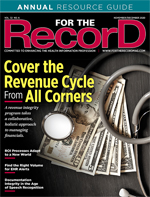November-December  2020
2020
Evolving Education: The Key to Successful Resource Management Planning
By Beth Ottinger, RN, BSN, CPC, CCS
For The Record
Vol. 32 No. 6 P. 6
Business disruptions to health care organizations and hospitals, whether event driven (eg, COVID-19) or due to industry circumstance (eg, high employee turnover rates), can cause resource angst as leaders scramble to relocate colleague resources, try to fill gaps where there are resource shortages, or furlough or even lay off staff in areas where activity is slow. Depending on the magnitude of the disruption, steps to maintain productivity range from temporary reassignments to some of the more extreme actions many were forced to implement in 2020.
As of early September, fallout from the pandemic continues to impact health care. According to a Pulse Survey conducted by the Healthcare Financial Management Association, COVID-19 is still muddling medical coding and claims, and the high demand for health care resources continues to entice colleagues to leave their organization in search of greener pastures.
What solution can be implemented that helps organizations preserve steady output in their revenue cycle and fortifies colleagues with the information intelligence required to meet regulatory standards? Two things: resource management and education plans.
Build Education Into Your Resource Management Plan
To help manage the volume shift from the COVID-19 shutdown of outpatient procedures, many hospitals have shifted their outpatient coders to inpatient coding roles. Still more hospitals have cross-trained their patient access colleagues to assist with medical billing.
The ability of these health care organizations to quickly pivot their resources and shift them into much-needed roles was the result of formal education programs that were implemented into their resource management plans pre–COVID-19.
Once buy-in and support from leadership are gained, there are six suggested steps to take when implementing education into resource management plans:
• Form a team of representatives across the revenue cycle to manage and monitor the program.
• Conduct assessments of colleagues’ current knowledge levels. It’s an effective method for determining where training should begin. Assessments also are useful in the new colleague onboarding process—and for colleagues who train others. Organizations don’t want colleague trainers passing on incorrect or outdated information.
• Identify and prioritize knowledge gaps and roll out education in those areas first.
• Develop education maps for colleagues to follow in order to gain the education they need for a role. Building maps as guides is a crucial step—they will prove helpful as resources for future training and for education expansion. The maps should include a preassessment followed by course topics in a chronological sequence. For example, if an outpatient coder is training to become an inpatient coder, start with a basic course topic such as foundational diagnostic inpatient coding. Then add the content required for subject mastery.
Once you identify all topics and content, add in practice tools so colleagues can run through exercises and simulations to enhance their aptitude.
• Conduct a second assessment of colleagues who have completed their education to determine role readiness.
• Create a colleague recognition program for those demonstrating readiness to assume new or higher responsibilities. For example, one organization presented colleagues with certificates plus pins to attach to their badges.
How to Increase Success
Certification and badge programs can be ideal components of a resource management plan, offering training for colleagues who want to stay in their current role and enhance their knowledge level. Those wanting to move to a different position within the revenue cycle also could benefit. Plus, organizations can customize the programs to include training that’s specific to their processes and standards.
One major health care organization developed a “Patient Access University” to tackle challenges such as turnover, colleague satisfaction, succession planning, remedial training, and denial prevention. For example, once entry-level colleagues had been trained and gained enough experience, they found new positions at other organizations for more money. All this turnover was costly—up to 33% of the average colleague’s salary.
Another organization created training for their patient-facing staff on how to handle difficult, critical conversations with patients regarding financial responsibility. Partnering with an education organization, it developed a three-tiered program that included certification exams at the end of each level training.
The certification and badge program helped build a career progression plan. In less than two years, these efforts are paying off. For example, agreement with the statement, “I feel I am valued in this organization” has risen from 66% to 79%. Also, agreement with the statement, “My pay is fair for the work I perform” has risen from 46% to 67%.
Generational Learning
There are five generations currently in the US workforce:
• Generation Z, those born from 2001 to now;
• Generation Y, those born from 1981 to 2000;
• Generation X, those born from 1965 to 1980;
• Baby boomers, those born from 1946 to 1964; and
• Traditionalists, those born pre-1946.
Each generation has its own preferred method of learning. Not surprisingly, Generations X, Y, and Z know their technology and want succinct, engaging education that meets their visual learning styles. What does all this mean for an education program? Simply that it’s best to offer a blend of teaching methods—traditional instructor-led classroom, PowerPoint style, interactive, gaming, animation, videos, and self-paced webinars.
Maintaining resource management plans that contain effective colleague education programs is an investment that delivers a solid return by sharpening the skills of an organization’s greatest assets: its colleagues.
— Beth Ottinger, RN, BSN, CPC, CCS, an AHIMA-approved ICD-10-CM/PCS trainer, is vice president of product management education at nThrive.



